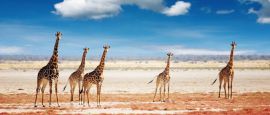Founded by Franz Lüderitz, a Hamburg merchant, the town became a German protectorate in 1883 and thrived when diamonds were found in nearby Kolmanskop. Today, its surreal German art nouveau architecture, built in the late 1880s to early 1900s in a seemingly unforgiving landscape, is the main tourist attraction. Kolmanskop, now a ghost town, is also worth a visit.
Namibia things to see and do
Namibia's national parks and game reserves cover 18% of the country's area. Namib-Naukluft is the country's largest conservation area and is characterised by rolling red dunes and rocky escarpments where desert animals roam. Etosha National Park is probably the most popular and is home to 114 mammal species and over 400 bird species. On the other side of the scale, Khaudum National Park in the remote Kalahari Desert welcomes more elephants than visitors to the park.
This coastal city is a magnet for adventure seekers keen to explore the dunes, ride the waves, kayak to see a massive colony of seals in Pelican Point, or join a cruise in search of dolphins. The spectacular views of flamingos and pelicans on the tidal lagoon shouldn't be missed too.
Damaraland refers to the vast swathes of land covering the north-central region. Highlights include Twyfelfontein and Brandberg Mountain for prehistoric rock engravings – of which the White Lady of the Brandberg is best known, and Spitzkoppe, Burnt Mountain and Organ Pipes for geological wonders. The north side of Damaraland also has a large number of wildlife, including gemsbok, zebra, hyena, elephant and the endangered black rhinos.
The Fish River Canyon is Africa's largest canyon and the highlight here is a five-day 90km (56mi) hiking trail along the canyon floor to the Ai-Ais Hot Springs. As there are no shelters and no provisions along the way, all hikers may supply a medical certificate as proof of good health and apply for a hiking permit in advance. The trail is open from mid-April to mid-September.
Despite the ominous name, the Skeleton Coast is strikingly beautiful. Stretching 500km (310mi) across northern Namibia, the otherworldly landscapes of shifting dunes, gravel plains and wide expanses of sand, punctuated by ghastly sand-covered shipwrecks, are wild yet captivating. The sand here sings, too – moving sand creates a noise that resembles rumbling thunder, which the locals call 'the lion's roar'.
Swakopmund is another colonial town that has retained a decidedly European feel, with attractive old German houses dotted around and many restaurants serving German classics. Swakopmund is also a thriving seaside resort – you can swim in the ocean, kayak to see the seal colony at Pelican Point, venture into the Namib-Naukluft National Park or explore the Skeleton Coast.
The Caprivi is a narrow strip of land protruding from the north-eastern corner of Namibia and stretching eastward towards Zambia. This is the rainiest area in Namibia and naturally, you can expect lush vegetation and rich wildlife, including more than 450 species of bird. The best time for bird watching is from November to April – the nesting period for native species while many migrating birds are also present.
The attractive Namibian capital features German colonial architecture including the iconic Christuskirche (Christ Church), which resembles a gingerbread house. A tour of the National Museum and National Botanic Garden is also recommended. In the centre of Post Street Mall, Windhoek's shopping hot spot, there's a quirky display of the meteorites that hit southern Namibia in prehistoric times.
Do you have any Feedback about this page?
© 2025 Columbus Travel Media Ltd. All rights reserved. No part of this site may be reproduced without our written permission, click here for information on Columbus Content Solutions.








 You know where
You know where